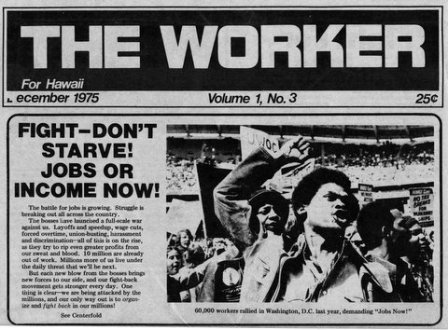
First Published: The Worker, for Hawaii, Vol. 1, No. 3, December 1975.
Transcription, Editing and Markup: Paul Saba
Copyright: This work is in the Public Domain under the Creative Commons Common Deed. You can freely copy, distribute and display this work; as well as make derivative and commercial works. Please credit the Encyclopedia of Anti-Revisionism On-Line as your source, include the url to this work, and note any of the transcribers, editors & proofreaders above.
Five hundred students gathered in Chicago in mid-November for the Second National Convention of the Revolutionary Student Brigade. These days when the newspapers write about students, they call them apathetic and say that the desire of students to change the world is a tiling of the past. But the convention proved this a lie, and marked an important step in building a powerful student movement that will fight shoulder to shoulder with the working class.
The convention began as students from all over the country discussed the struggles students are involved in and the sentiment on the campuses. College education, never available to many working class young people, is becoming more and more out of reach, as schools cut back enrollment, raise tuition, and eliminate programs that students and others fought for to make education available to the masses of young people. For those able to stay in school, the quality of education is rapidly sinking, as teachers and campus workers are laid off, class sizes increased, and facilities cut back.
Many of the convention participants came from the thick of big struggles, where students are fighting to keep their education from being another victim of the crisis of the system. The convention also discussed the growing threat of war and how more and more students on the campuses are saying they won’t stand by while the country is dragged into war to prop up the profits of the corporations.
The students involved in the anti-cutback fights want to know why these attacks are coming down, and who’s to blame. One student at the convention described how he had joined the Brigade. He became involved with the Brigade through the fight against a particular cut. Originally, concern about the cutbacks led him to the Brigade, who were the only people offering a program to fight them. In the struggle he came to understand and agree that the ruling class of capitalists was at fault, and not just for the cutbacks, but other things on his mind–the decay of his city, what the hell he was going to do for a job, and so on. He summed up by saying he wanted to go back to the campus and organize.
Already thousands of students in New York are fighting against the cuts–5,000 marched right up to the governor’s office! In New Jersey, ten thousand students wore armbands against proposed tuition hikes. The Brigade has been involved in these struggles and has been bringing out that in New York, for example, the education cuts are only part of a massive attack on the working people of New York–especially city workers–as the capitalists close hospitals and fire stations, lay off tens of thousands of workers, impose wage freezes and steal pension money. And the struggle of students is only one part of much wider resistance to this and must be united with the fight-back of others.
The struggles students are waging today take place as the country is more and more being rocked by the growing battle of the working class against the capitalists. Students are able to see that the workers are a more powerful force, in a stronger position than students to deal blows to the bosses, and are eager to link up with them.
The students at the convention represented the revolutionary fighters on the campuses; those who are not only the most active in the struggles, but who see the need for the complete overthrow of the capitalist system. In the huge student movement of the 1960’s, which grew mainly out of the fight against the Vietnam war, many students came to see the bankruptcy of the whole system and the need for revolution.
But at that time the workers struggle was not so sharp as today, and few revolutionary-minded students were able to see the enemy clearly or actually what revolution means in a country like the US. It is partly for this reason, as well as the end of the war, that the student movement of the 60’s faded. For while the students hatred for oppression never disappeared, many saw that they could not do away with the system on their own.
Students, like all young people are full of energy and are looking for a better future, refusing to accept things just because “that’s the way they are”. At the convention the delegates discussed the need to show the masses of students that there is a way out of the mess of capitalism, and how this can only be through revolution by the working class and the building of a new, socialist society.
In order to be able to clearly point out the nature of the enemy to the millions of students, and to help make their struggle a powerful ally of the workers in all their struggles, including the growing battle to end capitalism, the RSB voted to become the communist student organization of the Revolutionary Communist Party, the newly formed Party of the working class in the US.
The student movement has made important contributions to the over all struggle of the working class, not only by hitting hard at our common enemy, but also by helping to expose the outrages of the capitalist system to millions of people–as during the Vietnam War. With the revolutionary students fighting more closely with the working class and linking with its Party, the student movement will make much greater contributions in the years to come.